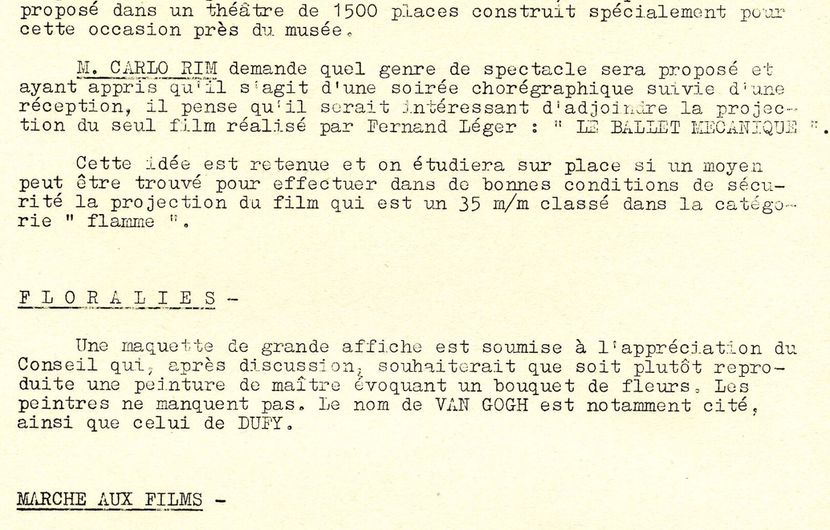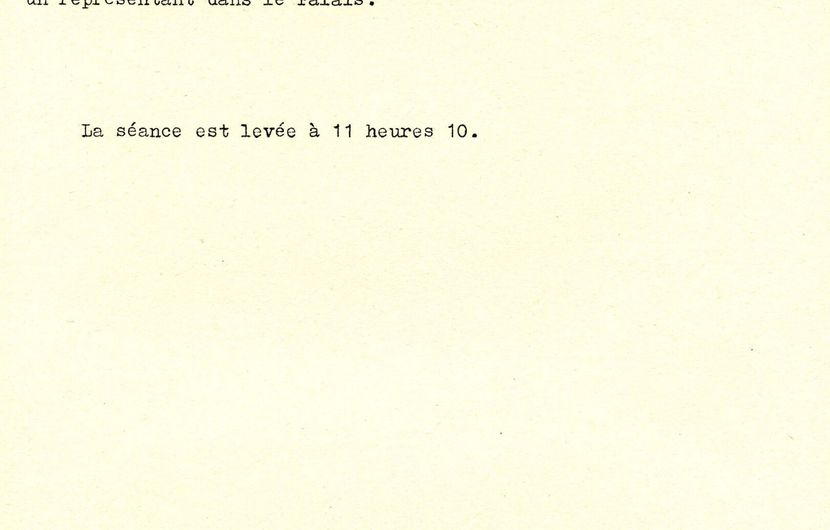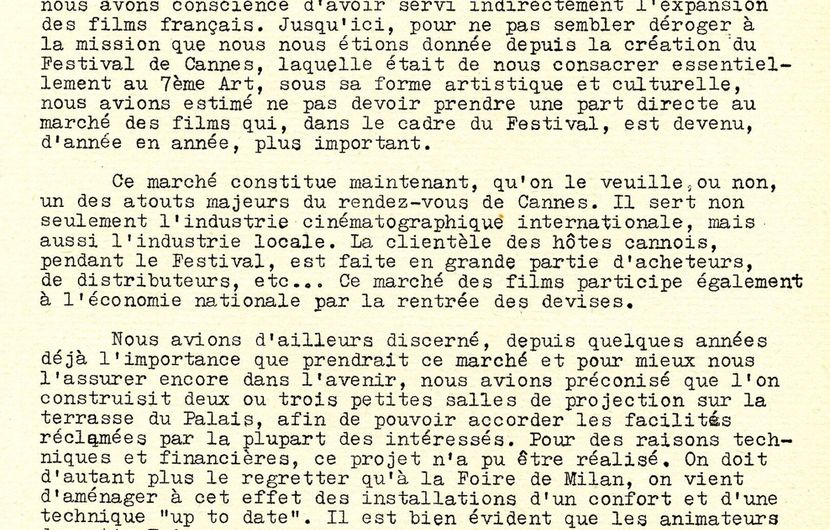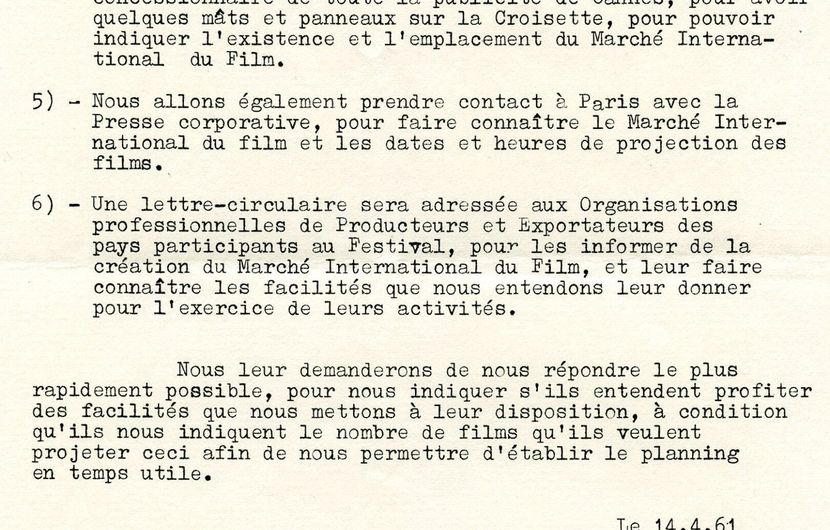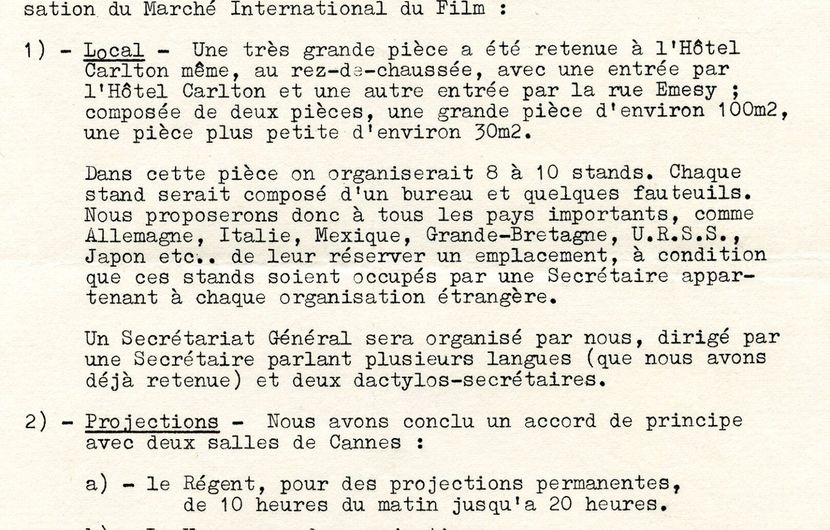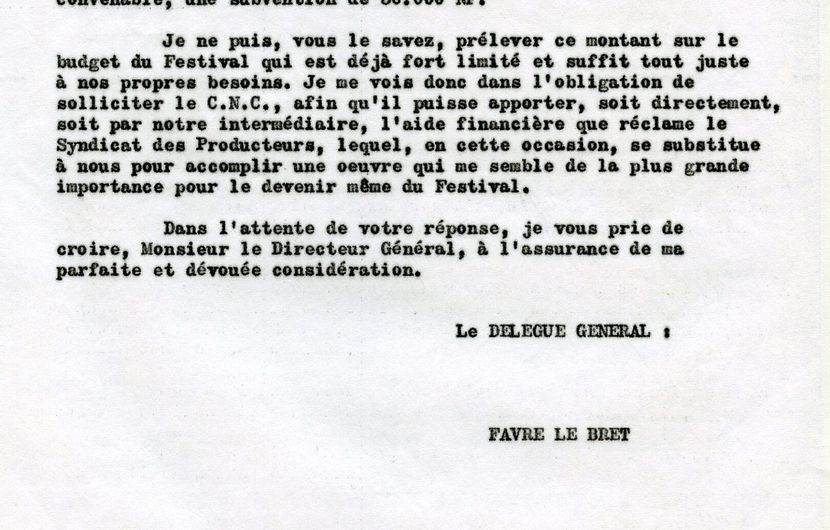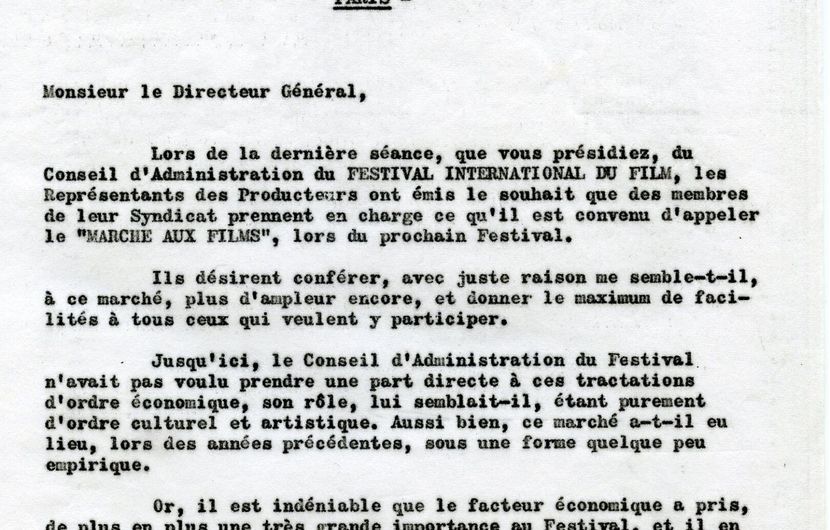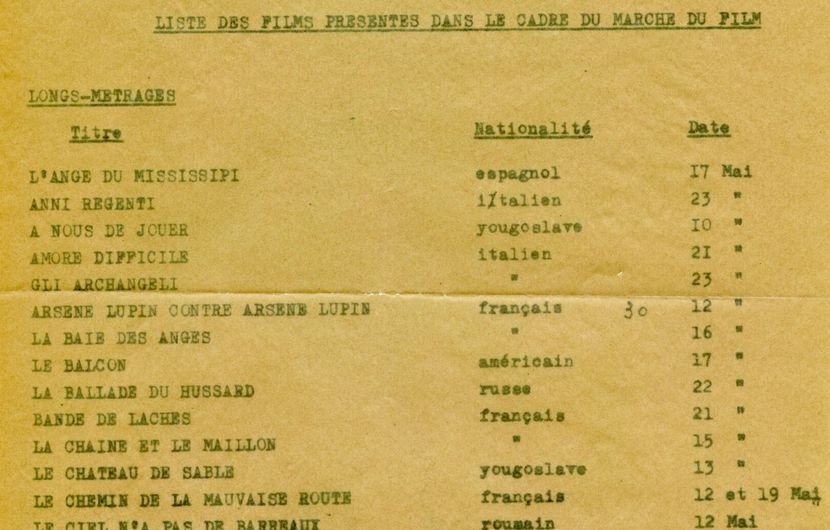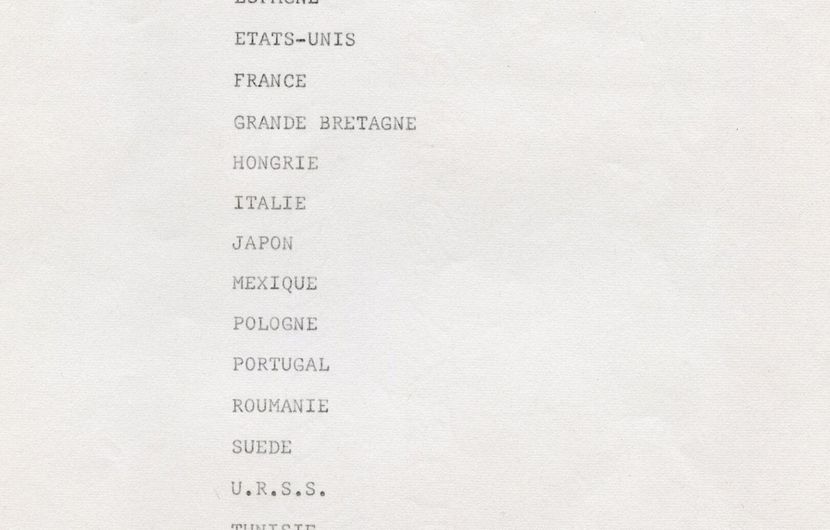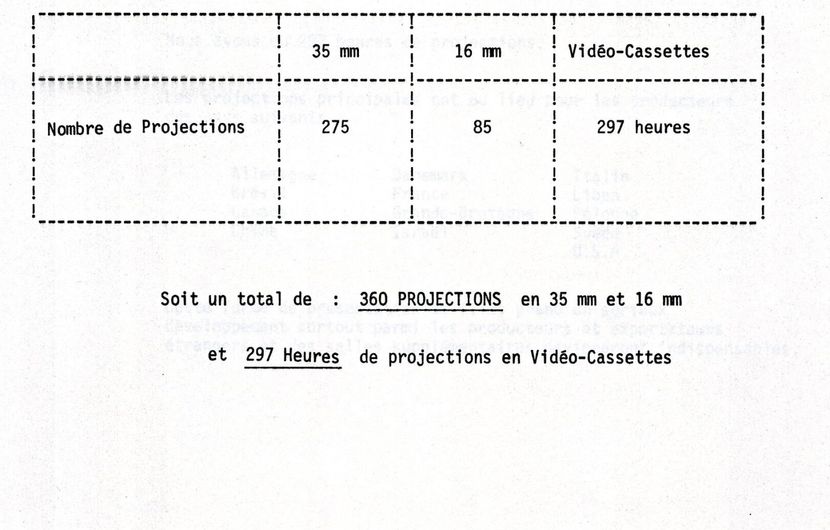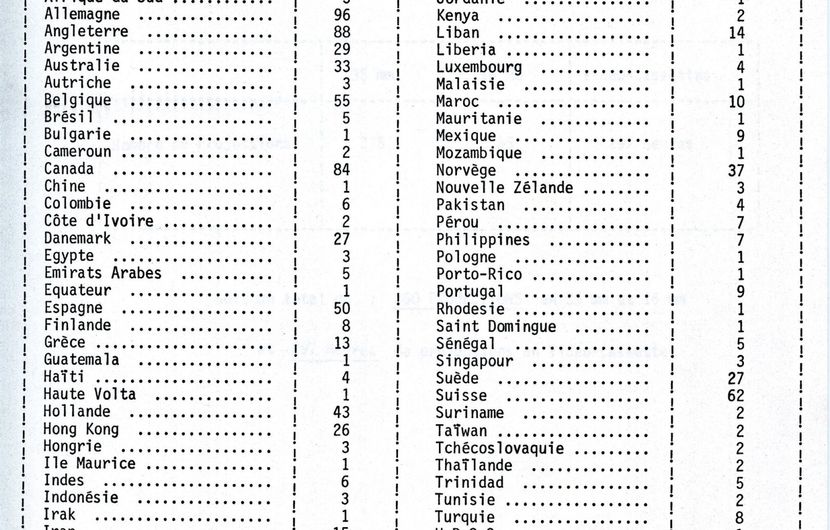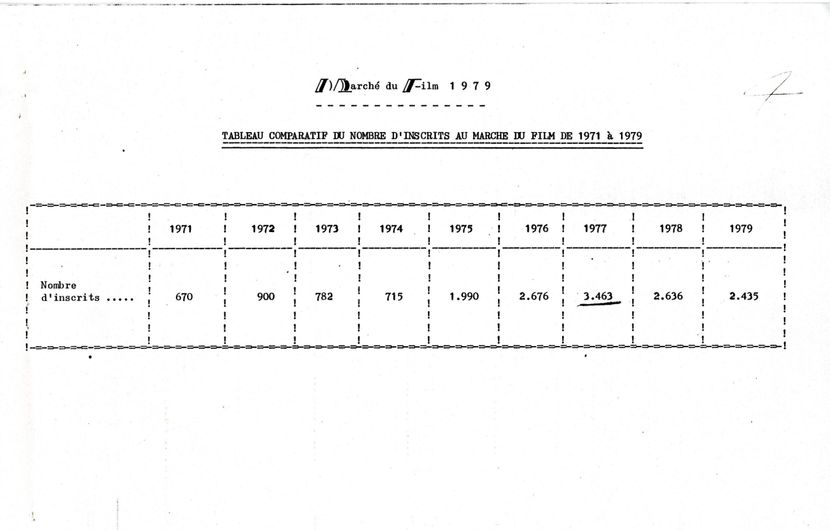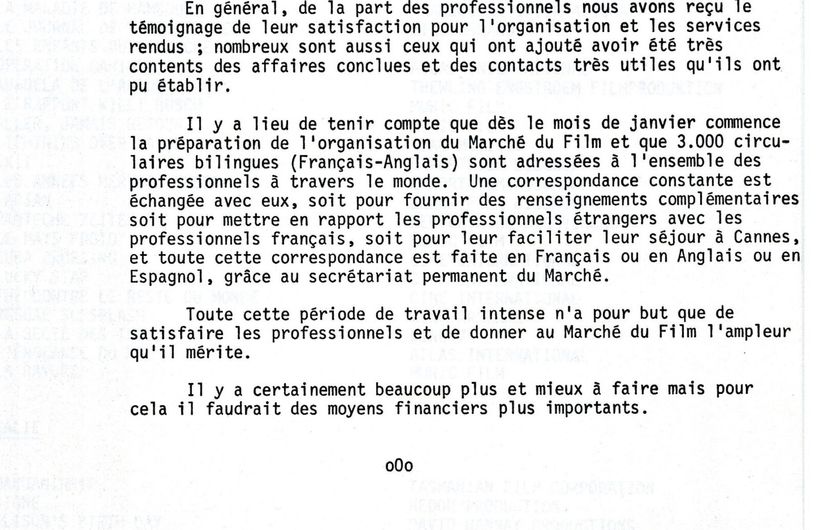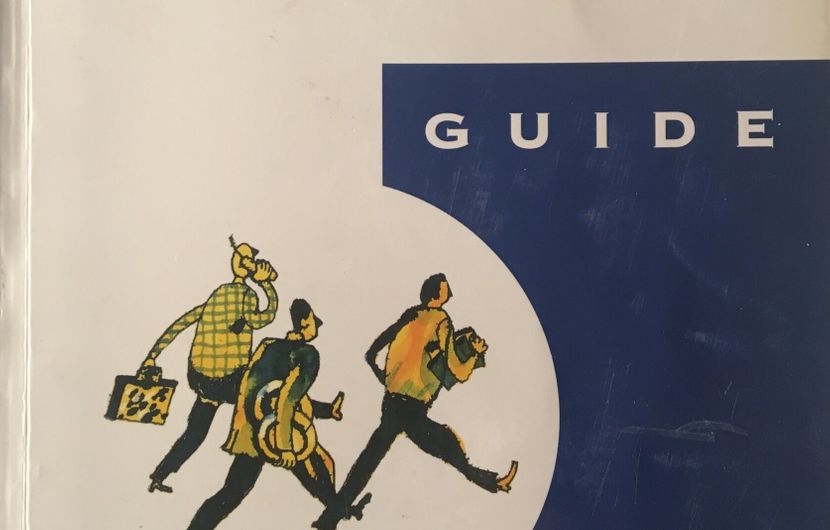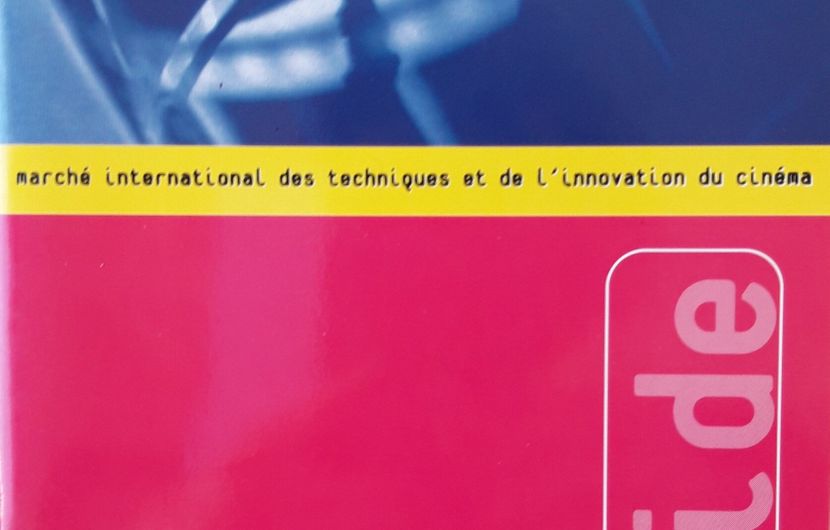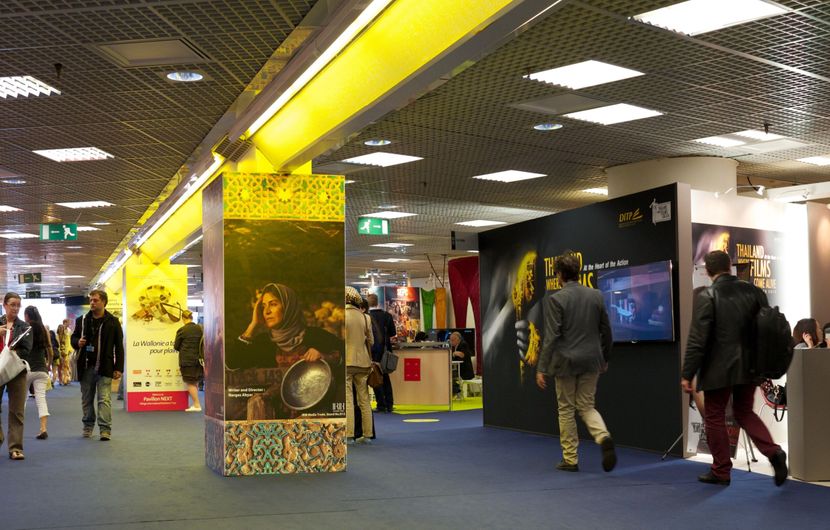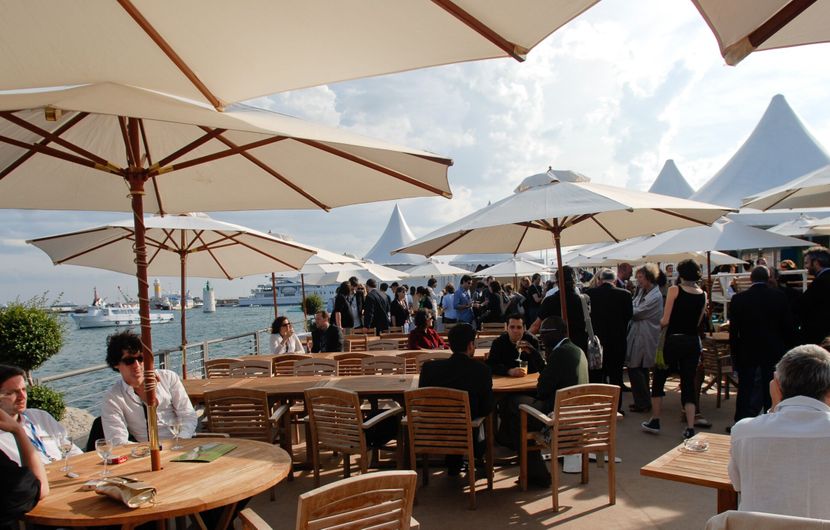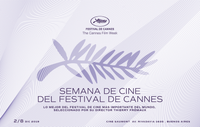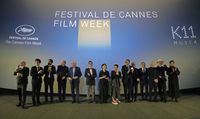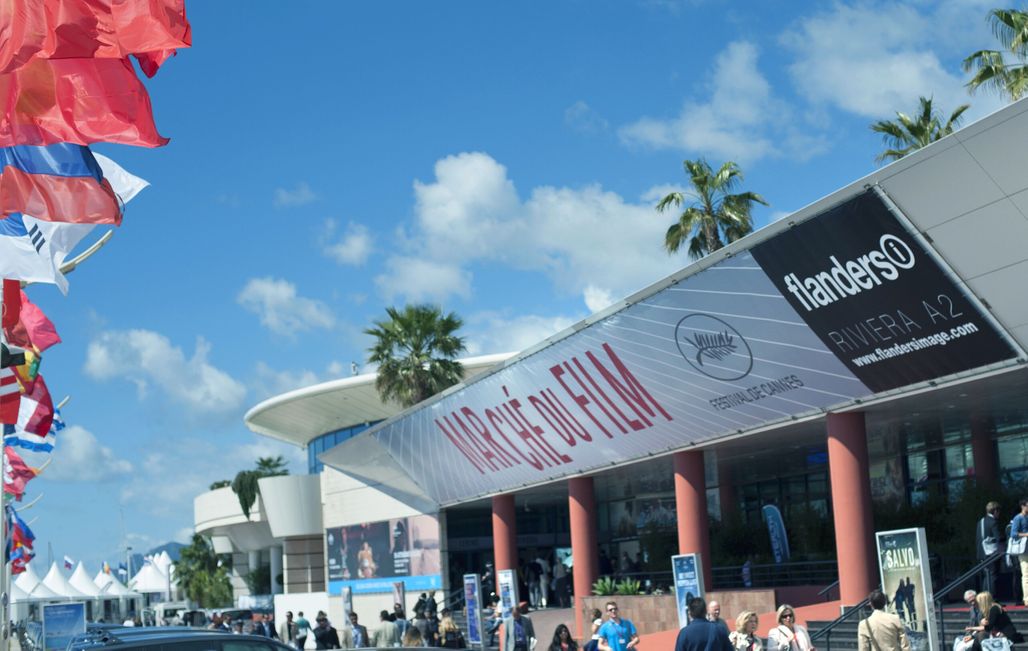
As the Marché du Film celebrates its 60th anniversary, the International Film Festival looks back over the history of an event that became a calendar highlight on Cannes' cultural scene, from its beginnings to the present day.
How it all began: an informal event
Production companies began being invited to the Festival de Cannes from the very first edition in 1946. For the first few years, they didn't have their own VIP area, instead gathering in cinemas on Rue d'Antibes, hired specifically for the occasion. The events were an opportunity for professionals to meet and network with a view to buying and selling film rights.
In 1950, Robert Favre Le Bret, the Festival's General Delegate, suggested incorporating this informal, unofficial market into the core event's line-up, but the Festival Committee rejected the idea, fearing that the screenings required for the market would outshine those displayed as part of the Festival itself. They also felt the Festival should remain a primarily cultural and artistic event, and were wary of lending it a blatant economic or financial slant.
Very early on, Robert Favre Le Bret was aware of the need to take film industry-specific challenges into account in developing the event. In 1953, a highly explicit line was added to the Festival Rules, which had until then only provided details on the event's dates. This line clarified the Festival's dual-faceted role in "fostering cinema and supporting the growth of the film industry around the world".
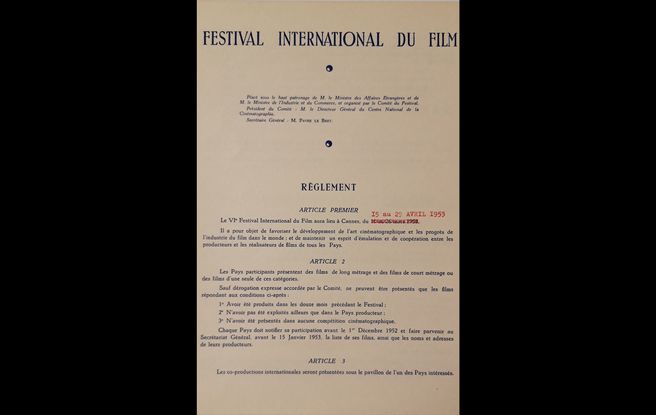
The Marché du Film is Created
In 1959, this unofficial market for film industry representatives, called the 'Festival de la Rue d'Antibes', boasted screenings to rival those taking place at the Festival de Cannes. In light of its undisputed success, Minister for Culture André Malraux and Robert Favre Le Bret decided to make the market an official part of the Cannes event.
On 1 March 1960, the Festival's Executive Board discussed the Marché aux Films that was developing alongside the Festival. With the Milan film market growing ever slicker and more professional, the Board decided to give producers and buyers the facilities they needed, creating a liaison bureau in the Palais des Festivals to foster ties between foreign producers and the customs authorities, with a representative appointed to the Palais to facilitate getting copies of films to the Marché.
Initially, the Marché developed organically, with a few dozen participants and a single projection room to seat around 20 guests, built from wood and canvas and located on the rooftop of the old Palais.
When the Marché du Film first launched, a few disgruntled voices made themselves heard, in particular film critics who accused the Festival of becoming a 'film fair' that prioritised the commercial aspects of the industry. Luckily, other journalists recognised the Marché for what it was: a central component of ensuring the Festival could grow.
As ever in Cannes, the press whipped up a media storm, and rumours ran rife.
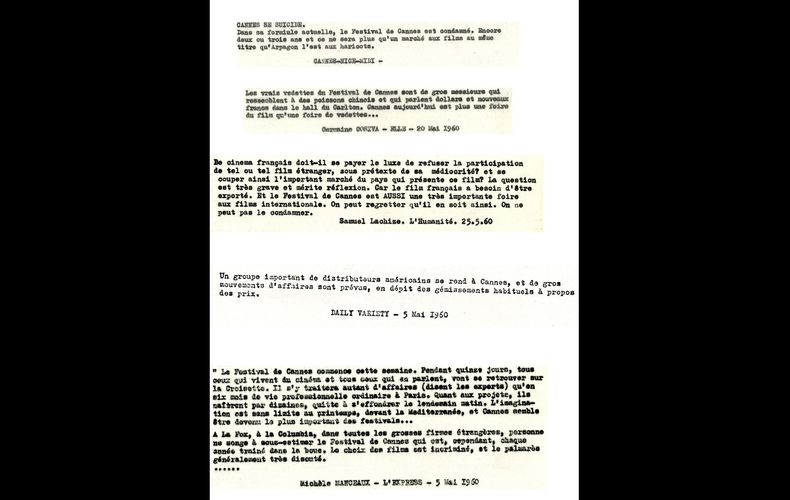
Extracts of press articles describing - and more or less criticising - the rise of the Marché du Film, May 1960 © DR
The annual report for the 13th Festival summarised the initial conclusions of this loosely-structured Marché, describing the economic and financial aspects of the film industry as its "lifeblood". The Festival's Management refused to bow to pressure from the critics, and stated that "whether you approve or disapprove, this Marché is now one of Cannes' key calendar highlights". Robert Favre Le Bret then began working on the idea that the Marché needed to be expanded and better organised to meet industry needs and rival Milan's film market (MIFED), an event first established in 1960 and boasting an international outlook and more structured approach. He envisaged the Festival playing a pro-active role in organising the Market "with support from professional unions that may be interested".
In 1961, the Chambre Syndicale de la Production Cinématographique Française, France's film production union, volunteered to run the Marché. Robert Favre Le Bret backed this initiative, brought it before the CNC (France's National Centre for Cinematography), and applied for a small grant, which was ultimately approved. Two members of the Chambre Syndicale des Producteurs de Films Français (France's film producer union), Emile Natan and Bertrand Bagge, were appointed to oversee the organising.
After a first test run in 1960, the Marché International du Film was born in 1961, and soon garnered interest.
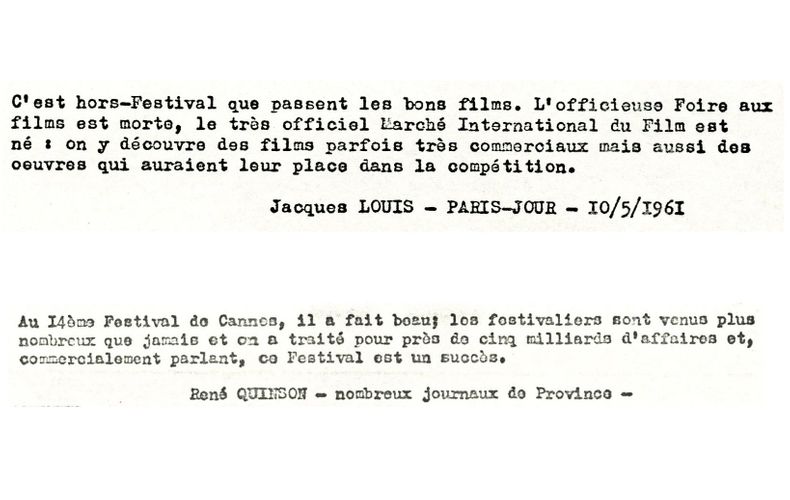
Extracts of press articles describing the rise of the International Marché du Film, May 1961 © DR
The Festival de Cannes had been catapulted to world renown, and international associations of producers, distributors and exporters wanted the Marché itself to take on an international dimension.
By establishing the Marché du Film, the Festival reasserted its position as a figurehead in the development of the film industry, and demonstrated its unique role as a marketplace for film industry professionals from around the world.
Beki Probst, founder and director of the EFM (European Film Market) at the Berlin International Film Festival, continues to attend the Marché du Film, and remembers her first few years at the Festival as if they were yesterday: "My first experience of the Festival was as a journalist in 1958, but in the sixties and seventies, I also attended as an operator, accompanying the delegation of operators and distributors from French-speaking Switzerland. This busy delegation never missed a Marché du Film, had significant budgets and was highly sought-after by those seeking to sell their films".
Rapid expansion and international visibility
The Marché du Festival grew with each passing edition of the Festival, with Cannes town council eventually deciding to build an extension to the Palais: a first wing to house a couple of stands, and three small, spartan rooms. The extension soon revealed itself to be insufficient, and in the late seventies, the council built a second, temporary wing between the Palais and La Malmaison, to house four screening rooms, a film-checking room and a room for video, which was just beginning to emerge.
Transactions between producers, exporters and operators weren't limited to the Palais, with the city's bars, restaurants, luxury hotels and beaches all transformed into impromptu trade floors.
Alain Vannier, Chairman of Orly Films and film producer and exporter, has been attending the Marché du Film for sixty years now. "My first Festival was in 1959! I made the trip there and back to bring them a copy of Alain Resnais' Hiroshima mon amour, as the screening of a Russian film was cancelled. In those days, the Marché du Film was in its early stages, and mostly took place at the old Palais des Festivals and the Carlton: the hotel bar between 11am and 1pm was the place to be to talk business. The Blue Bar was another iconic venue and hotspot. We also met on the beaches, we always knew where to go to find one another. At the Carlton, you'd have all the major producers, the Americans, the English, and the French Film offices. The Majestic was where you'd find the technical specialists, and the Martinez was for the Italians! We hired cinemas on the Rue d'Antibes for screenings. I had some thrilling nights there, such as in 1973 when Marco Ferreri's La Grande Bouffe came out, and I was the film's exporter. The Marché was a lot more rough-and-ready back then, but it was also much more festive".
Jacques-Eric Strauss, another producer and a French film rights seller, looks back over his first few years at the Marché du Film: "In the early sixties, the Marché was much more relaxed, we talked business over hotel lunches or on the beach. The Marché happened around the Palais Croisette and Rue d’Antibes where the films were screened in the city's cinemas. Film posters were plastered all the way down the Croisette. In the seventies, I was selling my own productions abroad, and the Marché's atmosphere was incredibly lively" .
The Festival tirelessly focussed on improving how the Marché du Film was structured and organised.
Screenings were held in Cannes' cinemas. Slowly but surely, the infrastructure, number of projection rooms, and the space available for stands grew alongside the Marché, which had become the ultimate annual highlight for film industry professionals around the world. With each passing year, the Marché's participant, country and projection numbers swelled.
Over the years, the ever-growing Marché du Film emerged as an international event designed, organised and structured around a single key objective: to bolster film in all its guises.
Yet the brakes were slammed down on the Marché du Film as a result of a lack of space and infrastructure, as noted by the Marché du Film's report in 1980. A new Palais des Festivals was sorely needed if the event was to continue to grow.
In the late eighties, the Festival was slated for its poor organisation, seen as outdated by industry professionals, with Screen International and Variety seeming to concur. In July 1980, Robert Favre Le Bret wrote to the Mayor of Cannes to warn him that American distributors were planning on boycotting Cannes and organising their own competitor market in the United States. The first edition of the American Film Market (AFM) took place in Los Angeles in March 1981, and it became more urgent than ever to equip Cannes with a new Palais des Festivals.
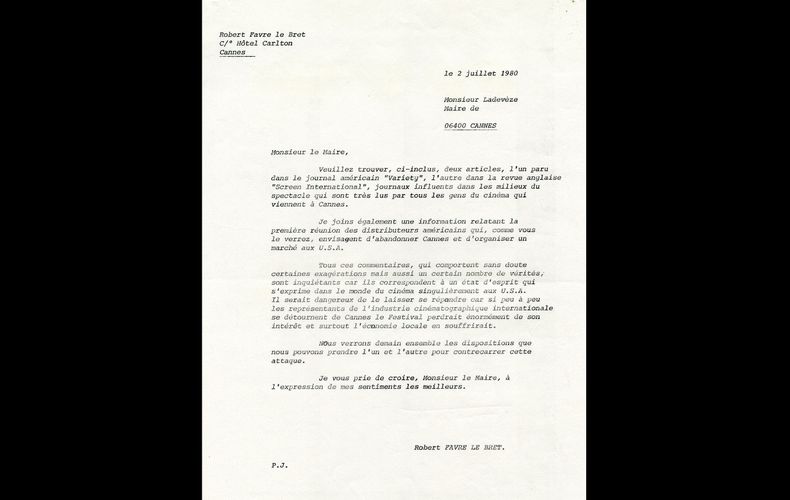
Correspondence from Robert Favre Le Bret to the mayor of Cannes detailing the critics and the threat from the American boycott, July 1980 © FDC
The new Palais des Festivals opens in 1983
With the artistic and financial stakes higher than ever, and the need to host an ever-growing number of participants making itself felt, the town council had a new Palais des Festivals built; a shining embodiment of the success of both the Festival and the Marché du Film, now the world's biggest and best-known film market.
In 1979, the Marché's newly-appointed director, Marcel Lathière, took over from Robert Chabert and Marc Imhaus, and began preparing for the move to the new Palais des Festivals, which was inaugurated in 1983.
In 1980, the Festival's Association set up the Marché International du Film's General Secretariat, headed up by Managing Director Michel P. Bonnet and Co-Director Marcel Lathière. The new duo succeeded in lending the event a sense of structure.
Danièle Birgé, Head of the Marché's Screening Department from 1982 to 2018, witnessed the last year at the old Palais Croisette and the moment when the Marché was moved to the brand-new Palais des Festivals:
"After years of hard work, the new Palais des Festivals was hotly-anticipated by both organisers and professionals, with the opening planned for the Festival's 1983 edition. In truth, the Palais wasn't quite ready when May rolled around, but neither Cannes town council nor the Festival's organisers could afford to back out: the entire world was ready and waiting for the big day! The inauguration was met with pomp and splendour, and the industry professionals were thrilled with the new, sweeping sense of space, the many different projection rooms, and the open-plan areas designed for the stands… It was such a welcome change after the tight, cramped spaces at the old Palais Croisette. Unfortunately, some of the work done on the building had been rushed. When a raging storm hit the Croisette, the rain came flooding into the building: stands were drenched and the bathrooms looked like swimming-pools. Luckily, work resumed in late May, and the Palais was fully ready for 1984's edition of the Festival".
The Marché's management team rapidly became aware of the film industry's emerging needs, and set up a number of new departments, film registration fees, professional stand hire, and other facilities. In 1989, the Marché clocked in 600 screenings in its brand-new Palais des Festivals.
In 1987, Lady Diana and Prince Charles visit the Festival de Cannes' Marché du Film
The information age
In the nineties, the Marché International du Film began producing and developing a huge array of different tools for its participants: Directories, global market statistics, databases, and more.
In 1996, Jérôme Paillard was appointed to replace Marcel Lathière, with a vision of developing the Marché even further and consolidating the Marché's ties with the city's cinemas.
As soon as he moved into his office, Jérôme Paillard gave an interview in Film Français, stating that: "The most exciting new feature is that from now on, the Marché will be bringing together all professionals in Cannes, irrespective of location. The Marché is intended as a home for all businesses on the Croisette." Some companies had left the Marché to set up shop on the Croisette and in Cannes' hotels. To get these companies back into the Marché du Film, Jérôme Paillard created a comprehensive compilation of all the information that had previously been scattered, creating a series of new services and tools, notably "The Guide", the ultimate handbook for film industry professionals. The Guide became available in CD-ROM format in 1997, and as a database in 1999, a forerunner to Cinando, which first saw the day in 2003.
This new information economy became a powerful driving force for the booming Marché du Film. As IT, telecommunications and audiovisual tools converged, they gave rise to new potential, major challenges and profound cultural changes, all at once.
The MITIC/1998 – 2001
Founded in 1998, the MITIC (International Market for Technology & Innovation in Cinema) became a leading annual event for emerging technologies, including digital ones, and encompassing an exhibition area, talks and conferences, demonstrations and screenings to introduce industry participants in Cannes to these new technologies. In a matter of years, digital technology became a firm fixture in the film industry.
Today, the Marché du Film is a key event for showcasing new information and communication technologies, both of which became central to filmmaking and remain a key part in anticipating the film industry of the future.
The Riviera
Building on this success, the space grew in the noughties, with the arrival of the Riviera and Lérins, forming a central hub built around the Palais des Festivals and the Village International, where all international film is promoted.
The Palais des Festivals' new extension provided the space needed to bring together an array of sales companies in a single 7,000 m2 seafront exhibition space. The Riviera is home to another eight new cinemas, bringing the total number of rooms available for professionals up to 25.
Director of Operations, Marketing and Sales Myriam Arab worked for the Marché du Film from 1990 to 2014, and remembers the high-impact campaign that was rolled out to lure companies in when the Riviera opened:
"Jérôme (Paillard) and I hit the streets in Los Angeles to convince America's most powerful sellers – who hung around at the Carlton, Martinez or Majestic – to come and join us at the Riviera. This was the first time that the Marché had organised a soirée outside of Cannes, and our AFM (American Film Market) stand was the first time we had travelled to a market as an exhibitor. The Riviera's promotional night at the AFM, complete with a mock-up of the building brought over from Paris, was a hit. When the Riviera opened its doors, every last square foot had been snapped up!".

Aerial photo of the riviera and the Village International, 2006 © Marché du Film
Exporting the Marché du Film
Cinando
In 2003, Jérôme Paillard founded Cinando, the world's very first online international film industry database, which quickly became the number-one online network for cinema professionals, offering a collection of tools to help users navigate the film industry (database of films and projects in development, participant lists, screening schedules at all major markets throughout the year, etc.).
Thanks to Cinando, the Marché du Film now covers most of the sector's biggest events (AFM, Filmart, Ventana Sur, the Berlin International Film Festival, Sundance, Toronto, Busan) and represents 73,743 individuals, 3,629 buyers, 80,402 films, 10,747 projects, and 2,039 screeners.
Ventana Sur: a snapshot of Latin America
The Marché du Film exports its expertise, too. Founded in 2009 in partnership with the National Cinema and Audiovisual Institute (INCAA), Ventana Sur takes place in late November/early December in Buenos Aires, and over the past decade or so has become Latin America's biggest market for audio-visual content, bringing together different professionals in the audio-visual industry to promote co-production, funding, and international distribution for Latin American content.
The Marché du Film today: one vision, one goal
12,411 film industry professionals were accredited in 2018, and now flock to the Marché du Film to screen to discover around 4,000 films and projects in the 33 projection rooms.
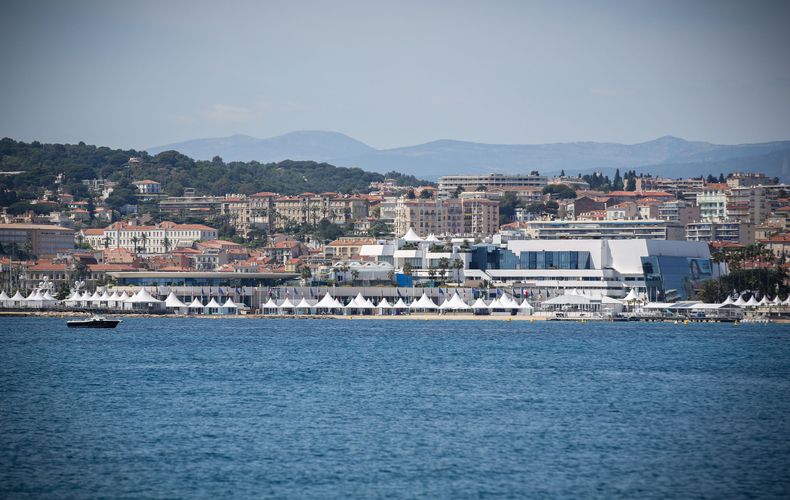
Le Palais des Festivals © Thomas Leibreich / FDC
Over the last ten years or so, the Marché du Film has been focussing on creating tools and platforms that foster networking, interaction and exchange, thanks to a series of different programmes that allow professionals to come together around shared interests, from virtual reality and documentaries, to co-production, new technologies and innovation.
The Village International's pavilions provide a platform for over 60 countries and are spaces where professionals and film institutions from around the world can meet, showcase their new projects, sign deals and promote their industry.

The pavillions of the Village International, 2016 © FDC
As an all-important component of the prestigious film festival, the Marché du Film has become an essential stepping stone for creating, producing and distributing films around the globe, and is home to the world's biggest international community of film professionals. The Marché has been working towards the same goal from the very start: helping all film succeed.
Since its beginnings, the Marché du Film's greatest, unique asset lies in the sheer diversity of its many participants. Irrespective of their field, expertise or country, these professionals come to the Marché to share ideas, secure funding, seize opportunities and soak up the atmosphere at the cutting edge of the international film industry.
The Festival de Cannes and the Marché du Film are inseparable, interdependent entities, and have become limelight-sharing stars on a single stage, as well as a driving force for world cinema and the film industry. What makes Cannes so special and unique is its role as both market and festival.
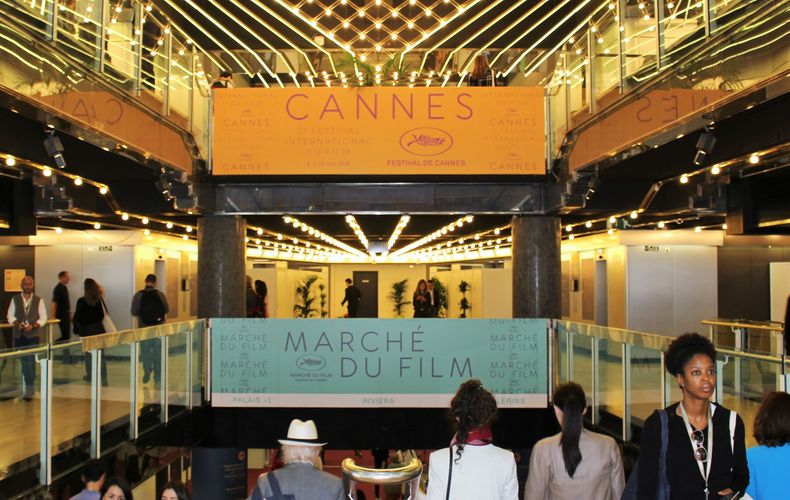
Entrance to the Palais des Festivals; the Festival and its Marché welcome the attendees © Marché du Film
Over the past 60 years, the Festival de Cannes and its Marché du Film have grown hand in hand, both serving as perfect embodiments of Article 1 of the Festival de Cannes' regulations.
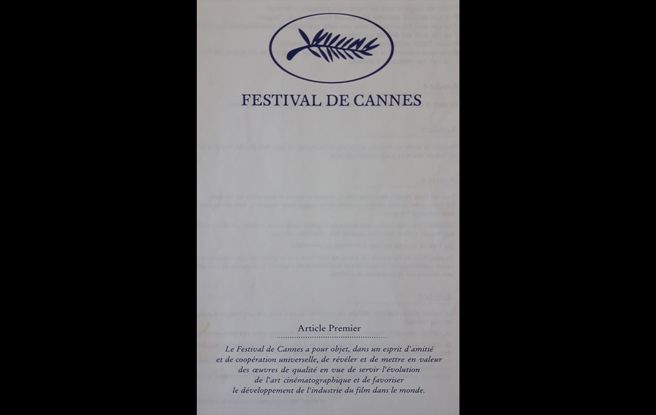
Article 1 of the International Film Festival's regulations 1953
Marché du Film statistics – available to view in the Festival's archives at the Film Library
BIFI.INV.00615
Marché du Film report 1980 – available to view in the Festival's archives at the Film Library BIFI.INV.00615
Marché International du Film Guide 1996
MITIC Guide 1998
Article 1 of the Festival de Cannes' rules, unchanged since 1973

